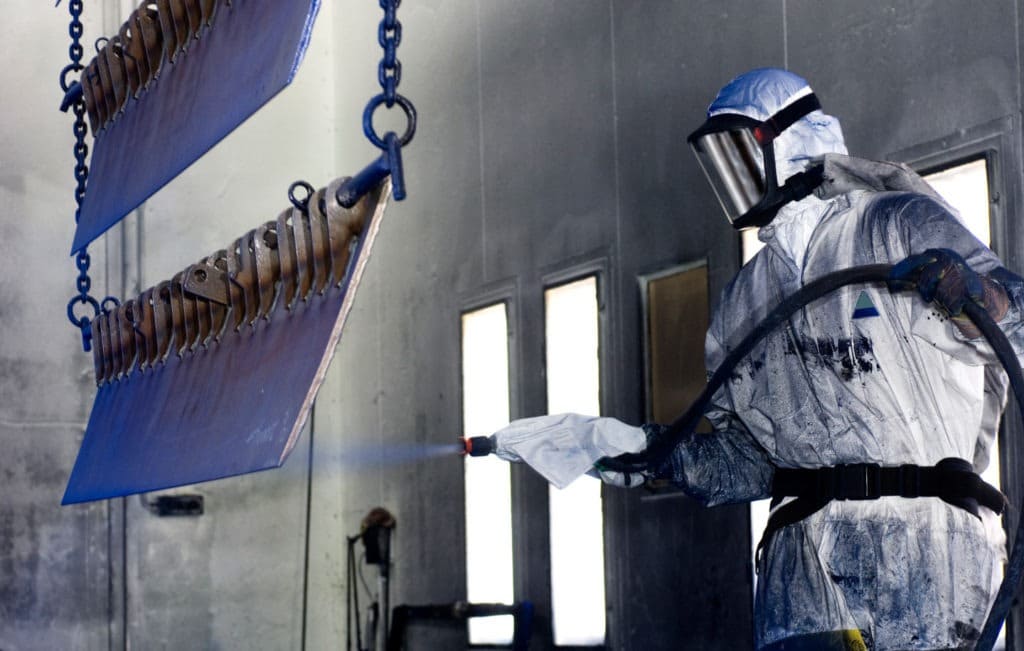Work-related respiratory disease is not just one singular disease. The term covers a range of illnesses that are caused or made worse by breathing in hazardous substances in the workplace. Substances that damage the lungs can be specks of dust, fumes or gases. The most prevalent of the diseases that are termed occupational respiratory diseases are chronic obstructive pulmonary disease (COPD), asthma and silicosis.
12,000 Deaths A Year
Overall there are currently approximately 12,000 deaths each year due to occupational respiratory disease. Two-thirds of these deaths are due to asbestos-related diseases or COPD. In addition, according to the HSE, there are about 35, 000 people who worked in the last year, and 130,000 who had ever worked who currently have breathing or lung problems they thought were caused or made worse by work. There is also a further estimated 13,000 new cases each year.
Industries With High Prevalence
There are a number of industries and workplace activities across the UK which is linked to a high incidence and greater risk of respiratory disease. This may be because there is a large population of potentially exposed employees or there is evidence of a high incidence rate. These priority industries are:
- Construction workers
- Foundry workers
- Welders
- Quarry and stone workers
- Agricultural workers
- Vehicle paint sprayers
- Bakery workers
Occupational Health Strategies
Within each of these industries, it is important to introduce occupational health strategies that you can use to control respiratory disease exposure and ensure the lung health of your employees as part of your health and safety policy. Key among these would be the use of personal protective equipment where necessary. It is also worthwhile to consider including a health surveillance strategy in your overall planning. In this way, you can continually assess the ongoing health of your employees.
Lung Function Testing in The Workplace
As part of a health surveillance strategy in these industries, it is important to include lung function testing in the workplace. Spirometry will be a good indicator of any damage to an employee’s lungs and will flag any employee who may need a referral. This strategy protects your employees and your business. We have outlined in further detail the process and employer’s obligations in relation to lung function testing here. Let’s look at each industry in isolation, the issues and the intervention tactics in place. We will also detail where you can get good information.
Construction workers:
Construction workers have a high incidence of respiratory problems, with the main cause being exposure to dust and respirable crystalline silica (RCS). Exposure to RCS can result in silicosis. Other prevalent respiratory diseases amongst construction workers are COPD and asthma. Asbestosis is reducing exponentially within this industry but it has been a large concern in the past.
Key Activities That Put Employees At Risk
There are certain key activities that may put employees at risk of developing respiratory disease. The activities where exposures occur include:
- kerb/paving/block-cutting
- stone masonry/stone floor laying
- tunneling/demolition and chasing out/re-pointing.
Nationwide Initiatives
Partnership groups have been formed to design and implement initiatives to tackle RCS exposure in particular. These groups are composed of trade associations, professional organisations, suppliers and vocational training organisations that represent the cross-section of industries where risks from exposure to silica are present. Examples of interventions that these groups have undertaken include:
- Leaflets outlining the dangers of dust.
- Events for employers design to raise awareness of risks and control methods.
- Developing standards for on-tool extraction
- Undertaking research projects to better understand and reduce RCS exposure.
By registering, information on these and other initiatives is available on the Occupational Disease Community site run in conjunction with the HSE. Specific guidance for employers on health risks in construction is available on the construction web pages on the HSE site.
Foundry workers:
Foundry workers can be exposed to multiple harmful substances including fumes and specks of dust, nickel compounds and RCS. Exposures can lead to a number of lung diseases including asthma and silicosis and are associated with the generation of dusts and fumes, or the actual usage or creation of harmful materials during processing.
Nationwide Initiatives
Partnership groups have been formed to design and implement initiatives to tackle issues in the Foundry Industry. These groups are composed of trade associations, professional organisations, suppliers and vocational training organisations that represent the cross-section of industries where risks from exposure to silica are present. Examples of interventions that these groups have undertaken include:
- A research study involving occupational hygiene surveys at foundries known to use good working practices, establishing a baseline occupational exposure dataset, characterizing good control practice, identifying practicable improvements and applying simple and effective control measures.
- Foundry Industry Safety and Health Foundry Targets Initiative (SHIFT) forums for sharing information
By registering, information on these and other initiatives is available on the Occupational Disease Community site of the HSE. Specific guidance for employers on reducing the incidence of respiratory disease is available on HSE’s foundries web pages.
Welders:
The fumes given off by welding and hot cutting processes is a varying mixture of airborne gases and very fine particles which if inhaled can cause a number of respiratory diseases. These diseases include asthma and cancer. The key activities that contribute towards exposure are arc, oxy-acetylene and resistance welding.
Nationwide Initiatives
Partnership groups have been formed to design and implement initiatives to tackle issues in the Welding Industry. The partnership group is comprised of trade associations, professional organisations, suppliers and vocational training organisations that represent a cross-section of industries where welding is present. Examples of interventions that these groups have undertaken include:
- A vocational learning package for welders.
- An independent website for the industry on the health effects from and control of exposures in welding.
- Developing messages on risks and control measures for employers and employees.
Information on these and other initiatives is available by registering on the Occupational Disease Community site on the HSE website. Specific guidance for employers on reducing the incidence of respiratory disease is available on HSE’s welding web pages.
Quarry and Stoneworkers:
Employees in this sector regularly undertake activities that can give rise to high and frequent exposures to Respirable crystalline silica (RCS). This can result in silicosis and Chronic obstructive pulmonary disease (COPD). Activities in the quarrying industry where exposures occur involve mining of high silica stone, sandpits, clay pits, blasting, breaking, crushing and screening. For stone workers, exposures result from work in fixed premises, work on high silica-content stone, cutting, grinding and chiseling.
Nationwide Initiatives
Partnership groups have been formed to design and implement initiatives to tackle issues in the Welding Industry. The partnership group is comprised of trade associations, professional organisations, suppliers and vocational training organisations that represent a cross-section of industries where welding is present. Examples of interventions that these groups have undertaken include:
- A training tool to raise awareness amongst quarry operatives/maintenance personnel.
- A vocational learning package for new-entrant stoneworkers.
- Free events for stoneworkers to raise awareness of the ill-health effects and suitable controls.
By registering, information on these and other initiatives is available on the Occupational Disease Community site on the HSE website. Specific guidance for employers on reducing the incidence of respiratory disease is available on HSE’s quarry industry pages and stoneworkers’ pages.
Agricultural workers:
Workers in the agricultural sector undertake activities where they are exposed to high levels of dust and micro-organisms. A common result of this exposure is respiratory illnesses such as bronchitis. Activities that lead to exposures and therefore possible respiratory disease include:
- Grain workers – harvesting, drying, storage, transport, dock activities, and associated maintenance/cleaning.
- Livestock, arable, vegetable cultivation and horticultural workers – preparation of bedding and feed, hay/haylage/silage making, straw bailing, harvesting/cleaning/grading vegetable crops, and flower bulb cleaning/grading/packing.
Examples of interventions for this sector include:
- Development of web pages to explain the risks from specks of dust.
- A series of free events for employers highlighting the risks of exposure to specks of dust and suitable controls.
Information on these and other initiatives is available by registering on the Occupational Disease Community site on the HSE website. Specific guidance for employers on reducing the incidence of respiratory disease is available on HSE’s agriculture web pages.
Vehicle paint spraying:
Workers undertaking vehicle paint spraying in the motor vehicle repair industry and motor and semi-trailer manufacturing are typically exposed to 2-pack (2K) isocyanate paints. Because of this exposure they can suffer from occupational asthma.
Intervention activities for this industry include:
- A vocational educational tool to raise awareness of respiratory health risks for those working and training in the motor vehicle repair industry.
Information on intervention initiatives is available by registering on the Occupational Disease Community site. Specific guidance for employers on reducing the incidence of respiratory disease in these workers is available on HSE’s asthma web pages. We also have further information in relation to biological monitoring for Isocyanates exposure here.
Bakery workers:
Bakery workers are exposed to high levels of flour dust and enzyme improvers. According to the HSE, just over a quarter of workers (approximately 27,000) in this industry are exposed to flour dust during the course of their work. This exposure to flour dust and improvers can result in occupational asthma.
Nationwide Initiatives
Partnership groups have been formed to design and implement initiatives to tackle issues in the Welding Industry. The partnership group is comprised of major supermarkets, Sector Skills Council and the Bakers Food and Allied Workers Union. Examples of interventions that these groups have undertaken include:
- A “supermarket benchmark” that sets the working practices and controls that inspectors expect to see in in-store supermarket bakeries.
- A bakers pocket card and poster to advertise key health and control messages.
- Two-day course ‘look after your lungs: dusting off the facts about bakery hazards’
Information on intervention initiatives is available by registering on the Occupational Disease Community site. Specific guidance for employers on reducing the incidence of asthma in bakery workers is available on HSE’s food and drink manufacture web pages.
Respiratory disease is a serious problem for the industry. It is imperative that this issue is included in your occupational health strategy. For the industries we have detailed here it is also imperative that they undertake occupational health surveillance of employees where necessary.
We have years of experience providing Lung Function Testing services to enable compliance with the Control of Substances Hazardous to Health Regulations. We provide Spirometry Tests and Workplace Lung Function Tests with expert technical advice and interpretation of the findings, as well as cost-effective and practical recommendations for solutions.
In the long term, these Lung Function Tests can help you proactively manage your employee health and prevent work-related health issues from arising.
Call us on 01455 243700 or contact us online with your questions about Health & Safety services or requirements in general, or to get a quote on our services







